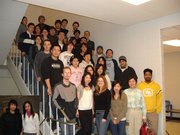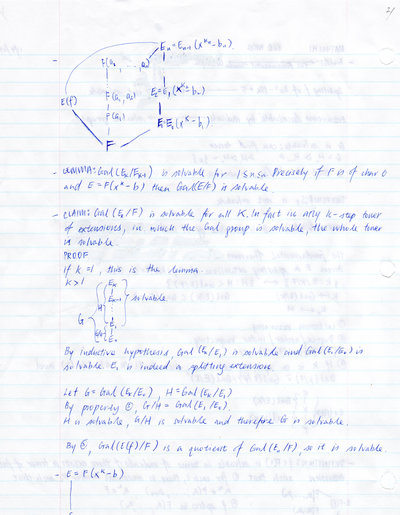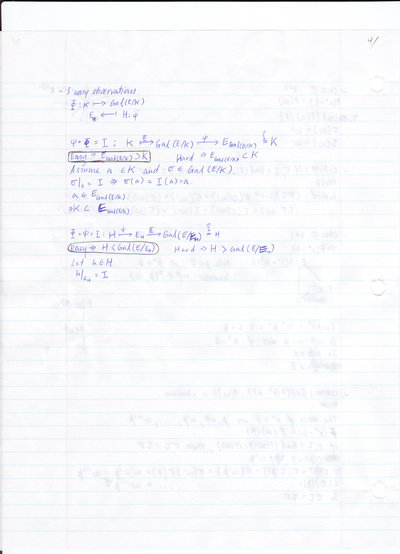07-401/Class Notes for April 11: Difference between revisions
No edit summary |
No edit summary |
||
| (4 intermediate revisions by 2 users not shown) | |||
| Line 28: | Line 28: | ||
==The Fundamental Theorem of Galois Theory== |
==The Fundamental Theorem of Galois Theory== |
||
'''Note.''' An updated version of this section is at [[08-401/The Fundamental Theorem]]. |
|||
It seems we will not have time to prove the Fundamental Theorem of Galois Theory in full. Thus this note is about what we will be missing. The statement appearing here, which is a weak version of the full theorem, is taken from Gallian's book and is meant to match our discussion in class. The proof is taken from Hungerford's book, except modified to fit our notations and conventions and simplified as per our weakened requirements. |
It seems we will not have time to prove the Fundamental Theorem of Galois Theory in full. Thus this note is about what we will be missing. The statement appearing here, which is a weak version of the full theorem, is taken from Gallian's book and is meant to match our discussion in class. The proof is taken from Hungerford's book, except modified to fit our notations and conventions and simplified as per our weakened requirements. |
||
| Line 42: | Line 44: | ||
{{Equation*|<math>\Psi:\quad H\mapsto E_H</math>.}} |
{{Equation*|<math>\Psi:\quad H\mapsto E_H</math>.}} |
||
This correspondence has the following further properties: |
This correspondence has the following further properties: |
||
# It is inclusion-reversing: if <math>H_1\subset H_2</math> then <math>E_{H_1}\supset E_{H_2}</math> and if <math>K_1\subset K_2</math> then <math>\operatorname{Gal}(E/K_1)>\operatorname{Gal}(E/ |
# It is inclusion-reversing: if <math>H_1\subset H_2</math> then <math>E_{H_1}\supset E_{H_2}</math> and if <math>K_1\subset K_2</math> then <math>\operatorname{Gal}(E/K_1)>\operatorname{Gal}(E/K_2)</math>. |
||
# It is degree/index respecting: <math>[E:K]=|\operatorname{Gal}(E/K)|</math> and <math>[K:F]=[\operatorname{Gal}(E/F):\operatorname{Gal}(E/K)]</math>. |
# It is degree/index respecting: <math>[E:K]=|\operatorname{Gal}(E/K)|</math> and <math>[K:F]=[\operatorname{Gal}(E/F):\operatorname{Gal}(E/K)]</math>. |
||
# Splitting fields correspond to normal subgroups: If <math>K</math> in <math>E/K/F</math> is the splitting field of a polynomial in <math>F[x]</math> then <math>\operatorname{Gal}(E/K)</math> is normal in <math>\operatorname{Gal}(E/F)</math> and <math>\operatorname{Gal}(K/F)\cong\operatorname{Gal}(E/F)/\operatorname{Gal}(E/K)</math>. |
# Splitting fields correspond to normal subgroups: If <math>K</math> in <math>E/K/F</math> is the splitting field of a polynomial in <math>F[x]</math> then <math>\operatorname{Gal}(E/K)</math> is normal in <math>\operatorname{Gal}(E/F)</math> and <math>\operatorname{Gal}(K/F)\cong\operatorname{Gal}(E/F)/\operatorname{Gal}(E/K)</math>. |
||
| Line 109: | Line 111: | ||
Clearly, <math>\rho</math> is a group homomorphism. The kernel of <math>\rho</math> is those automorphisms of <math>E</math> whose restriction to <math>K</math> is the identity. That is, it is <math>\operatorname{Gal}(E/K)</math>. Finally, as <math>E/F</math> is a splitting extension, so is <math>E/K</math>. So every automorphism of <math>K</math> extends to an automorphism of <math>E</math> by the uniqueness statement for splitting extensions. But this means that <math>\rho</math> is onto. <math>\Box</math> |
Clearly, <math>\rho</math> is a group homomorphism. The kernel of <math>\rho</math> is those automorphisms of <math>E</math> whose restriction to <math>K</math> is the identity. That is, it is <math>\operatorname{Gal}(E/K)</math>. Finally, as <math>E/F</math> is a splitting extension, so is <math>E/K</math>. So every automorphism of <math>K</math> extends to an automorphism of <math>E</math> by the uniqueness statement for splitting extensions. But this means that <math>\rho</math> is onto. <math>\Box</math> |
||
==Extra Practice Problems with Solutions== |
==Extra Practice Problems with Solutions== |
||
| ⚫ | |||
| ⚫ | Attached were some problems [[User:Clkkang]] found on the net with solutions. They may be very useful when studying for problems involving galois theory and other subjects. They were deleted by {{Dror}} for fear of copyright violations (it will be appropriate for [[User:Clkkang]] to post here links to the original sources of those pages). |
||
The following attachments are notes that [[User:Clkkang]] had taken from the text, it "MAY BE" a little easier to read than the text due to the formatting: |
|||
'''Extra Practice with Galois:''' |
|||
| ⚫ | |||
| ⚫ | |||
| ⚫ | |||
| ⚫ | |||
[[Image:07-401 Sample exam and solutions.pdf]] |
|||
'''A Little Less Galois, Extra Practice with Polynomials, Irreduciblity:''' |
|||
[[Image:07-401 minimal polynomial, Extensions.pdf]] |
|||
[[Image:07-401 Practice on -irreducible poly., min. poly, galois-.pdf]] |
|||
[[Image:07-401 Extensions and Galois.pdf]] |
|||
[[Image:07-401 Extensions and Galois Soln.pdf]] |
|||
[[Image:07-401 Min. poly, Ext., Proving Algebraic.pdf]] |
|||
'''Notes From The Text (MAY BE A little bit easier to read then text?)''' |
|||
[[Image:07-401 Ch 32 Notes Part 1.pdf]] |
[[Image:07-401 Ch 32 Notes Part 1.pdf]] |
||
==Class Notes== |
|||
| ⚫ | |||
| ⚫ | |||
| ⚫ | |||
07-401 Apr/04/11 LECTURE NOTES |
|||
[[Image:07-401 lecture 13 pg 1.jpg]] |
|||
==Page 2== |
===Page 2=== |
||
| ⚫ | |||
07-401 Apr/04/11 LECTURE NOTES |
|||
[[Image:07-401 lecture 13 pg 2.jpg]] |
|||
==Page 3== |
===Page 3=== |
||
| ⚫ | |||
07-401 Apr/04/11 LECTURE NOTES |
|||
[[Image:07-401 lecture 13 pg 3.jpg]] |
|||
==Page 4== |
===Page 4=== |
||
| ⚫ | |||
07-401 Apr/04/11 LECTURE NOTES |
|||
[[Image:07-401 lecture 13 pg 4.jpg]] |
|||
Latest revision as of 14:53, 2 April 2008
| |||||||||||||||||||||||||||||||||||||||||||||||||||||||||
Today's Agenda
- Today's the deadline for the prize problem from 07-401/Homework Assignment 7!
- Reminder of the Fundamental Theorem of Galois Theory.
- Proof of the insolubility of the quintic assuming the Fundamental Theorem.
- Proofs of the easy parts of the Fundamental Theorem.
- A short discussion of the final and and the time leading to it.
- Course Evaluation Forms and a Post-Mortem discussion in the spirit of 0506-1300/Post Mortem and of 06-240/Classnotes For Thursday December 7.
- With luck, early dismissal!
The Final Exam
As announced by the powers above, our final exam will take place on the evening of Tuesday April 24 between 7PM and 10PM, at New College Residence (NR) room 25.
The exam will be similar in style to the Term Test (also see On the Term Test). The material is everything covered in class. Everything in the test will be taken from our text book, and there will be two types of questions (or maybe sometimes the two types will be mixed within a single question):
- You may be asked to prove a theorem proven in class. The reason we prove theorems in class is that these proofs are valuable. Therefore I expect you to know them.
- You may be asked to solve exercises from the relevant chapters of the book, or minor variations thereof. These may be questions that were assigned as homework, but also, these may be questions that were not assigned before.
Office Hours. I (Dror) will hold extended office hours before the final, on Monday April 23 11AM-1PM and on the exam date, Wednesday April 24 10AM-12PM. You will be able to pick up all your graded assignments then and also on my last "normal" office hour, on Wednesday April 18 10:30AM-11:30AM. All office hours will be held at or near my office, Bahen 6178
Preparing for the Test. Read, reread and rereread everything and solve lots of exercises from the book.
My (Dror's) system when I was an undergrad was to prepare a 4-6 page 100-200 item list of points covered in class. I'd only summarize each point with one sentence, without giving any details and without trying to be precise, much like the list that I prepared for the class of February 7 (see On the Term Test). I would then go over my list again and again and again, crossing out every item for which I was sure I could complete all the details and supply all the proofs. I would only stop when there was nothing left to cross out.
Good Luck!
The Fundamental Theorem of Galois Theory
Note. An updated version of this section is at 08-401/The Fundamental Theorem.
It seems we will not have time to prove the Fundamental Theorem of Galois Theory in full. Thus this note is about what we will be missing. The statement appearing here, which is a weak version of the full theorem, is taken from Gallian's book and is meant to match our discussion in class. The proof is taken from Hungerford's book, except modified to fit our notations and conventions and simplified as per our weakened requirements.
Here and everywhere below our base field will be a field of characteristic 0.
Statement
Theorem. Let be a splitting field over . Then there is a bijective correspondence between the set of intermediate field extensions lying between and and the set of subgroups of the Galois group of the original extension :
The bijection is given by mapping every intermediate extension to the subgroup of elements in that preserve ,
and reversely, by mapping every subgroup of to its fixed field :
This correspondence has the following further properties:
- It is inclusion-reversing: if then and if then .
- It is degree/index respecting: and .
- Splitting fields correspond to normal subgroups: If in is the splitting field of a polynomial in then is normal in and .
Lemmas
The two lemmas below belong to earlier chapters but we skipped them in class.
The Primitive Element Theorem
The celebrated "Primitive Element Theorem" is just a lemma for us:
Lemma 1. Let and be algebraic elements of some extension of . Then there exists a single element of so that . (And so by induction, every finite extension of is "simple", meaning, is generated by a single element, called "a primitive element" for that extension).
Proof. See the proof of Theorem 21.6 on page 375 of Gallian's book.
Splitting Fields are Good at Splitting
Lemma 2. (Compare with Hungerford's Theorem 10.15 on page 355). If is a splitting field of some polynomial over and some irreducible polynomial has a root in , then splits in .
Proof. Let be a splitting field of over . We need to show that if is a root of in , then (so all the roots of are in and hence splits in ). Consider the two extensions
The "smaller fields" and in these two extensions are isomorphic as they both arise by adding a root of the same irreducible polynomial () to the base field . The "larger fields" and in these two extensions are both the splitting fields of the same polynomial () over the respective "small fields", as is a splitting extension for and we can use the sub-lemma below. Thus by the uniqueness of splitting extensions, the isomorphism between and extends to an isomorphism between and , and in particular these two fields are isomorphic and so . Since all the degrees involved are finite it follows from the last equality and from that and therefore . Therefore .
Sub-lemma. If is a splitting extension of some polynomial and is an element of some larger extension of , then is also a splitting extension of .
Proof. Let be all the roots of in . Then they remain roots of in , and since completely splits already in , these are all the roots of in . So
and is obtained by adding all the roots of to .
Proof of The Fundamental Theorem
The Bijection
Proof of . More precisely, we need to show that if is an intermediate field between and , then . The inclusion is easy, so we turn to prove the other inclusion. Let be an element of which is not in . We need to show that there is some automorphism for which ; if such a exists it follows that and this implies the other inclusion. So let be the minimal polynomial of over . It is not of degree 1; if it was, we'd have that contradicting the choice of . By lemma 2 and using the fact that is a splitting extension, we know that splits in , so contains all the roots of . Over a field of characteristic 0 irreducible polynomials cannot have multiple roots and hence must have at least one other root; call it . Since and have the same minimal polynomial over , we know that and are isomorphic; furthermore, there is an isomorphism so that yet . But is a splitting field of some polynomial over and hence also over and over . By the uniqueness of splitting fields, the isomorphism can be extended to an isomorphism ; i.e., to an automorphism of . but then so , yet , as required.
Proof of . More precisely we need to show that if is a subgroup of the Galois group of over , then . The inclusion is easy. Note that is finite since we've proven previously that Galois groups of finite extensions are finite and hence is finite. We will prove the following sequence of inequalities:
This sequence and the finiteness of imply that these quantities are all equal and since it follows that as required.
The first inequality above follows immediately from the inclusion .
By the Primitive Element Theorem (Lemma 1) we know that there is some element so that . Let be the minimal polynomial of over . Distinct elements of map to distinct roots of , but has exactly roots. Hence , proving the second inequality above.
Let be an enumeration of all the elements of , let (with as above), and let be the polynomial
Clearly, . Furthermore, if , then left multiplication by permutes the 's (this is always true in groups), and hence the sequence is a permutation of the sequence , hence
and hence . Clearly , so , so , proving the third inequality above.
The Properties
Property 1. If then and if then .
Proof of Property 1. Easy.
Property 2. and .
Proof of Property 2. If , then as was shown within the proof of . But every is for some , so for every between and . The second equality follows from the first and from the multiplicativity of the degree/order/index in towers of extensions and in towers of groups:
Property 3. If in is the splitting field of a polynomial in then is normal in and .
Proof of Property 3. We will define a surjective (onto) group homomorphism whose kernel is . This shows that is normal in (kernels of homomorphisms are always normal) and then by the first isomorphism theorem for groups, we'll have that .
Let be in and let be an element of . Let be the minimal polynomial of in . Since is a splitting field, lemma 2 implies that splits in , and hence all the other roots of are also in . As is a root of , it follows that and hence . But since is an isomorphism, and hence . Hence the restriction of to is an automorphism of , so we can define .
Clearly, is a group homomorphism. The kernel of is those automorphisms of whose restriction to is the identity. That is, it is . Finally, as is a splitting extension, so is . So every automorphism of extends to an automorphism of by the uniqueness statement for splitting extensions. But this means that is onto.
Extra Practice Problems with Solutions
Attached were some problems User:Clkkang found on the net with solutions. They may be very useful when studying for problems involving galois theory and other subjects. They were deleted by Dror for fear of copyright violations (it will be appropriate for User:Clkkang to post here links to the original sources of those pages).
The following attachments are notes that User:Clkkang had taken from the text, it "MAY BE" a little easier to read than the text due to the formatting:
File:07-401 Ch 32 Notes Part 1.pdf


















![{\displaystyle [E:K]=|\operatorname {Gal} (E/K)|}](https://wikimedia.org/api/rest_v1/media/math/render/svg/65c44a48df52c6cd4e1cf197de461b438c3270fd)
![{\displaystyle [K:F]=[\operatorname {Gal} (E/F):\operatorname {Gal} (E/K)]}](https://wikimedia.org/api/rest_v1/media/math/render/svg/93e40beb2ae7daa66244aff7daefbafd6cdeabf6)

![{\displaystyle F[x]}](https://wikimedia.org/api/rest_v1/media/math/render/svg/39bc9f9d8679fc385df3bccf9694283b796f3216)







![{\displaystyle p\in F[x]}](https://wikimedia.org/api/rest_v1/media/math/render/svg/05a3455e0a007d78c63b1dc8e435af11a6b61642)











![{\displaystyle [E:F]=[E(v):F]=[E(w):F]}](https://wikimedia.org/api/rest_v1/media/math/render/svg/5a24a256eb6de75a1dacd3d13f35be8efadfd320)
![{\displaystyle [E(w):F]=[E(w):E][E:F]}](https://wikimedia.org/api/rest_v1/media/math/render/svg/cf9b7193b8fa07c797b1af0959c6d9b4b7762d55)
![{\displaystyle [E(w):E]=1}](https://wikimedia.org/api/rest_v1/media/math/render/svg/a4d20b4e55660f62291fdc09da38821619ef10a0)

![{\displaystyle f\in F[x]}](https://wikimedia.org/api/rest_v1/media/math/render/svg/0ccbe5f3f86529d2b1b617a852f0368e16bba2d0)




























![{\displaystyle |H|\leq |\operatorname {Gal} (E/E_{H})|\leq [E:E_{H}]\leq |H|}](https://wikimedia.org/api/rest_v1/media/math/render/svg/b96ffe5b29c1554f6b894a0c96f4269a84687b53)






![{\displaystyle |\operatorname {Gal} (E/E_{H})|\leq \deg p=[E:E_{H}]}](https://wikimedia.org/api/rest_v1/media/math/render/svg/b87dc680a98caf9fd774e870cac71a68a0fa3c72)



![{\displaystyle f\in E[x]}](https://wikimedia.org/api/rest_v1/media/math/render/svg/a27b9340143e517d54bd068478c34f11db925016)






![{\displaystyle f\in E_{H}[x]}](https://wikimedia.org/api/rest_v1/media/math/render/svg/b5edef9ce94234e3fc6d1717113f139dfe7d1c67)


![{\displaystyle [E:E_{H}]=\deg p\leq \deg f=n=|H|}](https://wikimedia.org/api/rest_v1/media/math/render/svg/260f03cc2e78f96e758549476d640939be674ee6)


![{\displaystyle |\operatorname {Gal} (E/K)|=|\operatorname {Gal} (E/E_{H})|=[E:E_{H}]=[E:K]}](https://wikimedia.org/api/rest_v1/media/math/render/svg/f427ddcf1ee3a4e1c14a84b10a3b12f47ab03b20)
![{\displaystyle |\operatorname {Gal} (E/K)|=[E:K]}](https://wikimedia.org/api/rest_v1/media/math/render/svg/95b0089bc8be3ca20621ca2725e4cb413139b25c)
![{\displaystyle [K:F]={\frac {[E:F]}{[E:K]}}={\frac {|\operatorname {Gal} (E/F)|}{|\operatorname {Gal} (E/K)|}}=[\operatorname {Gal} (E/F):\operatorname {Gal} (E/K)].\quad \Box }](https://wikimedia.org/api/rest_v1/media/math/render/svg/a5e0026f7c5b4c2409b85fd4049c8315f9649c4a)


![{\displaystyle K[x]}](https://wikimedia.org/api/rest_v1/media/math/render/svg/8a9e6c2ac2830d6a9abe078b47450777c41d69a9)



![{\displaystyle [\sigma (K):F]=[K:F]}](https://wikimedia.org/api/rest_v1/media/math/render/svg/db763793f3462d90979c59370a529683a661e522)








